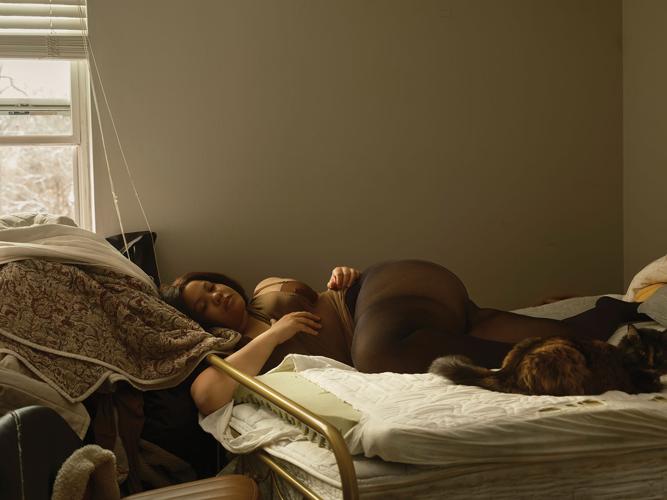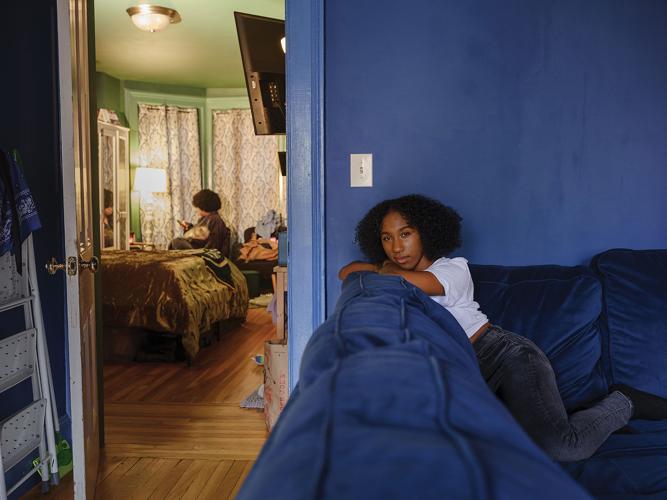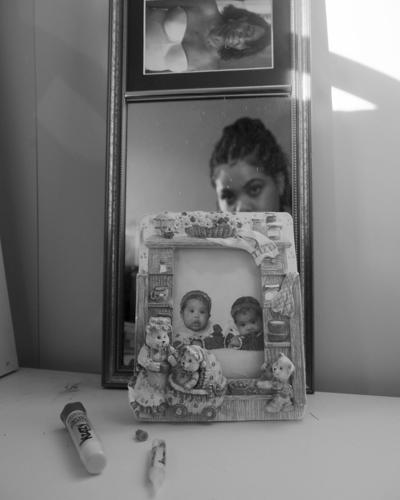
“We Don’t Deserve a Love Song,” Arielle Gray
In the middle of a Zoom call with the Scene, Arielle Gray’s twin sister steps into the camera’s frame and kisses her on the cheek, then walks away. It’s a quick moment, but an effective one — the 28-year-old photographer immediately drops her shoulders and pushes a braid behind her ear, visibly relaxing a bit.
“I see her as a soulmate,” Gray says of her sister, Iyana. “I see her as a mirror at times, but most of all I just see her as somebody that I draw inspiration from.”
Gray’s close bond with her twin has been both a grounding presence and a formative dynamic — someone to identify with, and also to define herself against. A graduate of Yale’s MFA program, Gray brings an intimate and rigorous eye to questions of identity, kinship and self-representation.
Gray relocated to Nashville to be with Iyana, who originally moved to the city to attend Vanderbilt and now works as a nurse practitioner. It’s a far cry from where they grew up, in an Alabama town of about 3,000 people called Moundville. “It was a bit of a Southern Gothic kind of upbringing. We grew up kind of isolated from other children, and we had a lot of playtime to ourselves with our mom, who was also a single mom.”
Her mom had a job at Lowe’s, and the three of them lived in a trailer next to Gray’s grandmother’s house. In many ways it was an ideal childhood, and some of her earliest memories include photography.
“Our mom used to take photographs of us on the hill in Moundville,” she says. “She would dress us up in, like, jean jackets and blow our hair out into afros, and she would just make us model for her. And that was sort of a part of our playtime, too.”

“Krazy Glue,” Arielle Gray
When she started studying photography at the University of Alabama, she found that she responded to it right away. She learned about foundational practitioners — Gordon Parks, Dorothea Lange, Sally Mann and Carrie Mae Weems. “It felt like a whole well of new knowledge, and something that kind of just stuck to me.”
Gray’s photograph “Krazy Glue” shows her range and knack for capturing complexity: a self-portrait that is also an image of a photograph of her and her twin, encased in a ceramic picture frame adorned with teddy bears that had just been repaired with Krazy Glue — an adhesive favored by her grandmother, whose own portrait is embedded in the piece. The whole thing is a tactile assemblage of women — a mirror image, a twin, an ancestor — held together in a fragile but intentional constellation.
The twin relationship recurs throughout photography, from Diane Arbus’ iconic 1967 photograph of identical twins in matching dresses to Deana Lawson, an acclaimed contemporary photographer who is herself a twin. In an essay in Lawson’s 2022 monograph, Eva Respini discusses the twin relationship directly. “The themes of duplication and identity might be seen as parallels to the artist’s own relationship to her sibling,” she writes. The same could be said of Gray, whose close bond with her twin has been both a source of strength and a constant mirror.

“Kayla in Blue Room,” Arielle Gray
Gray is in the process of creating a new body of work, which will be exhibited as part of a group show at Zeitgeist this summer. The Wedgewood-Houston gallery has long played an important role in the community by championing Nashville-based artists whose work might not fit in a more traditional commercial gallery. The summer show, curated by Alisa Jernigan and Evan Roosevelt Brown, will address themes of gathering.
In late April, a group of women gathered around a fire in an East Nashville backyard. They passed around chocolate cupcakes, wine and Topo Chi…
“I think that gathering — especially in regards to Black people gathering in spaces with and for ourselves — is going to be a really good highlight for the show,” she says. “I’ve still got a lot of work to do for it, but it’s a good challenge, because I feel like, down in the South, that is something that kind of grows like wildflowers down here. So I think it’s there. I just have to go get it.”
She’s making all new work for the show, and is still looking to connect with people to be in her photographs — specifically people who identify as Black and are 19 and older. Her preference is for interested people to contact her through email.
“I don’t want to limit the age range of who I photograph,” she says. “I want to bring people together, and I want to see what that looks like for me. I feel like there’s beauty in everybody, and I just want to photograph it.”





